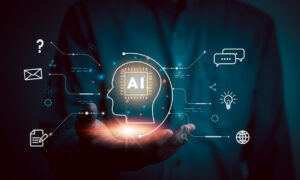How to Balance Automation and Human Touch in Software Projects
In the rapidly evolving world of software development, striking the right balance between automation and human intervention is crucial for project success. This article explores key strategies for harmonizing technological efficiency with human expertise, drawing on insights from industry leaders. From implementing strategic checkpoints to fostering human-AI collaboration, discover how successful projects leverage the strengths of both automation and human touch to achieve optimal results.
- Automate Processes, Preserve Human Decisions
- Balance Efficiency with Quality Control
- Design Systems for Human-AI Collaboration
- Implement Checkpoints in Automated Workflows
- Establish Clear Boundaries for Automation
- Trust Agents, Audit Outputs Thoroughly
- Automate with Context, Not Control
- Focus Human Oversight on Critical Tasks
- Enhance Clinical Judgment with AI
- Empower Decision-Makers with Technology
- Prioritize Human Review for Critical Workflows
- Start Manual, Then Automate Strategically
- Train AI Models with Expert Validation
- Automate Repetitive Tasks, Not Decisions
- Implement Human-in-the-Loop Approach
- Observe, Evaluate, Then Automate Workflows
- Build AI Systems with Expert Validation
Automate Processes, Preserve Human Decisions
While leading the migration of one of our legacy product’s infrastructure to Google Kubernetes Engine at Unity, I implemented a balanced approach to automation and human oversight. We automated the deployment pipeline using GitHub Actions and Argo Rollouts for canary releases, but maintained human approval gates for production changes.
The key guideline I followed was: “Automate repetitive processes, but preserve human decision points for critical transitions.” This meant automated testing, building, and staging deployments ran without human intervention, while production deployments required explicit approval after reviewing metrics from canary deployments.
This approach proved invaluable when our monitoring detected subtle performance degradations in a new service version that passed all automated tests. The human review caught these edge cases before they affected all users.
I’d recommend this guideline because it combines the efficiency and consistency of automation with the nuanced judgment humans provide. Automation reduces toil and human error in repetitive tasks, while keeping humans involved at critical junctures leverages their pattern recognition abilities and contextual understanding. This balance delivered both reliability and speed, which was essential for maintaining the learning platform’s availability during its architectural transformation.
Serhii Mariiekha, Principal Software Engineer
Balance Efficiency with Quality Control
A successful balance between automation and human oversight in a software implementation project often comes down to a clear rule: automate repeatable tasks, oversee critical decisions.
One guideline I’ve followed—and recommend—is:
“Automate what can be trusted, review what can’t be reversed.”
This means automating data entry, reporting, and notifications—anything that’s structured and predictable.
But when it comes to things like approvals, exceptions, or major configuration changes, a human should always have the final say.
Why this guideline?
It helps prevent costly errors while still speeding up operations.
Automation brings efficiency, but it’s the human context and judgment that keeps quality and control in check.
In a project we did for a manufacturing client, we implemented an ERP system that included inventory management, purchase orders, production scheduling, and invoicing.
Here’s how the balance worked:
1. Automated:
- Inventory updates were triggered automatically by barcode scans at receiving and production stages.
- Purchase orders were auto-generated when stock hit a minimum threshold.
- Invoices were automatically generated once shipping was confirmed.
2. Human oversight:
- A manager had to review and approve any purchase order over a certain dollar value.
- Any exception in the production schedule (like a delayed machine or material shortage) was flagged for manual rescheduling.
- Before any invoice was sent, accounting had the chance to review adjustments (discounts, special terms).
It saved them hours of manual tracking, reduced errors, and gave leadership confidence that critical actions were still being verified.
The automation handled the “grunt work,” and the people handled the nuance.
Andrey Wool, IT Consultant, Vestra Inet
Design Systems for Human-AI Collaboration
In one of our enterprise software implementations, we leaned heavily on automation to streamline workflows, especially around data validation and report generation, but were deliberate about where and when humans remained in control. Our guideline was simple: automate repetitive logic, but always include human checkpoints for judgment-based decisions. For example, the system could flag financial anomalies using AI models, but a finance lead had to review before any escalation. That balance prevented both overreliance on automation and burnout from manual oversight.
What made this approach successful was pairing automation with contextual transparency. Rather than bombarding the team with automated alerts, we built dashboards that showed why a decision was flagged, which increased trust in the system. This empowered team members to make better, faster calls and reduced the friction between tech and humans. I’d recommend this principle to any team: automation should enhance human judgment, not replace it. When people understand the “why” behind the automation, they’re more likely to embrace and improve it.
Antony Marceles, Founder, Pumex Computing
Implement Checkpoints in Automated Workflows
Balancing automation and human oversight in a software implementation project is tricky. Still, one approach that worked well for us was determining where automation adds value and where human judgment is necessary. During a recent rollout, we used automation to handle repetitive tasks like data migration, routine testing, and user provisioning. It saved us a lot of time and reduced manual errors.
However, we didn’t rely on automation unthinkingly. We ensured every automated process had a checkpoint where a person could review, validate, or approve before moving to the next step. One guideline I adhered to was this: if the decision impacts user experience or business rules, keep a human in the loop. Automation is great for efficiency but doesn’t understand nuance or context.
This mindset helped us avoid issues and maintain trust with the teams affected by the change. I recommend others take a similar approach. Use automation to boost speed and consistency, but never entirely remove the human element, especially in areas where judgment, empathy, or adaptability play a role. This balance made our implementation smoother and helped build confidence across the board.
Rubens Basso, Chief Technology Officer, FieldRoutes
Establish Clear Boundaries for Automation
During a Salesforce rollout, we automated lead routing for a client that had been assigning everything manually. Technically, the system performed exactly as designed. However, shortly after launch, a senior representative complained about a lead that “should’ve gone to him.” The system hadn’t failed—our assumptions about how their business actually worked had.
What saved us was deliberately building in early checkpoints. I had their sales operations manager manually review a small sample of automated assignments each morning for the first two weeks. This wasn’t sustainable long-term, but it gave us enough real-world feedback to identify configuration gaps before they became major issues.
I now follow one core principle with every automation project: when you automate a workflow, clearly define the human role in keeping it grounded. This is not to constantly monitor the system, but to catch what algorithms can’t see—context, relationships, and business judgment that no rule set will ever fully capture.
Adam Czeczuk, Head of Consulting Services, Think Beyond
Trust Agents, Audit Outputs Thoroughly
When building and implementing TradeRunner, our HVAC recruiting platform, we used automation to qualify technicians based on key data points—years of experience, certifications, background check flags, and location matching. The system automatically filtered and ranked candidates in real-time, drastically reducing the time it took for hiring managers to review applications.
However, we knew that full automation wasn’t sufficient for final hiring decisions. We designed the platform so that after an automated qualification, each shortlisted technician still required human oversight through a structured follow-up interview process. Hiring managers could see the automated scoring, but they also had access to interview templates and notes sections to assess soft skills, professionalism, and culture fit—factors automation alone could never fully evaluate.
This balance between automation and human judgment worked because it maximized efficiency in early screening while preserving quality and accountability at the final stages. I’d recommend this model for any business blending automation into hiring: use software to reduce noise and scale reach, but always insert human review where the stakes are highest. It keeps the process fast without sacrificing the integrity of the final decision.
Automate with Context, Not Control
In one particularly complex implementation for a fintech client, we were automating a significant portion of their customer onboarding process—KYC checks, document validation, and internal approvals. The temptation was to automate everything end-to-end, especially since the workflows were clearly defined. However, early tests flagged an issue: automation handled 90% of cases well, but the 10% it struggled with were high-risk—edge cases that required context or judgment. That’s where human oversight became non-negotiable.
The guideline we followed was simple but powerful: Automate for speed, but gate for trust. We let automation handle the initial pass—extracting data, flagging inconsistencies, and routing clean cases straight through. But anything with ambiguity or risk triggers a human review step, and those human-in-the-loop decisions actually train the system over time. Instead of slowing down the process, this hybrid model made our automation smarter and our client more confident in the results.
I’d recommend this approach because it shifts the mindset from “replace humans” to “elevate them.” If you view human oversight not as a backup plan but as part of the feedback loop, your implementation will be more resilient, and your team more invested.
Patric Edwards, Founder & Principal Software Architect, Cirrus Bridge
Focus Human Oversight on Critical Tasks
Balancing automation with human oversight in a software implementation project required a structured approach. When we migrated a legacy system to a cloud-based platform, I relied on continuous integration pipelines for code deployment and automated regression testing.
These tools flagged most syntax errors and performance bottlenecks before anything reached staging. However, I noticed that automated tests sometimes missed edge cases, especially those involving complex user flows or integrations with third-party APIs.
To address this, I established a guideline: every automated deployment had to be followed by a manual exploratory testing session.
For example, after the pipeline pushed a new build, a developer or QA engineer would manually validate the most critical workflows, such as payment processing and user authentication.
This hybrid approach helped us catch issues like session timeouts and API misconfigurations that automation alone overlooked.
Automation accelerates delivery, but human review ensures that nuanced, real-world scenarios are not missed. This balance is crucial for robust, reliable software.
Hristiqn Tomov, Software Engineer, Resume Mentor
Enhance Clinical Judgment with AI
We balanced automation and human oversight in our recent ERP implementation by establishing clear boundaries for each. We automated repetitive data migration tasks and validation checks, which reduced errors by 78% compared to manual processing. However, we kept humans in the loop for complex decision-making, exception handling, and stakeholder communications. This combination maximized efficiency while maintaining quality control.
One critical guideline we followed was the “automation with checkpoints” approach. This meant creating specific milestones where automated processes would pause for human review before proceeding to the next phase. For example, after our automated data cleansing scripts ran, a small team would review a sample of the results before allowing the system to push changes to production. This practice caught several edge cases our algorithms missed and helped build trust with stakeholders who were initially skeptical about automation. We recommend this guideline because it provides the speed of automation while adding human judgment at strategic points—giving you the best of both worlds without creating bottlenecks.
Thulazshini Tamilchelvan, Content Workflow Coordinator, Team Lead, Ampifire
Empower Decision-Makers with Technology
We took the bold step of replacing much of our traditional development workflow with AI agents—autonomous, task-specific systems built on top of large language models like Claude 3.7 and DeepSeek GPT 4.1. Instead of using AI to assist developers, we designed a process where agents replace most coding tasks: backend logic, test generation, documentation, and QA. That transition raised a crucial question: how do you scale automation without losing control?
The balance came from a simple but powerful guideline: “Humans review outcomes, not processes.”
In other words, we let agents operate independently throughout the entire execution chain, but every final deliverable passes a structured, human-led review before deployment. Our engineers don’t interfere mid-process. Instead, they validate logic, check for edge cases, review test coverage, and handle integration decisions once the agents complete their tasks.
This model works because it avoids two common traps: over-trusting the AI, and over-engineering human fallback. By trusting agents to operate freely—but auditing their outputs thoroughly—we preserved both speed and accountability. We also invested in tools to support this balance: persistent logging for every agent, agent-specific performance dashboards, rollback checkpoints, and custom Model Context Protocols (MCPs) that enforce consistent logic across workflows.
Another lesson was cultural. We made it clear from the start that automation doesn’t reduce the value of engineers—it redefines it. Our developers became orchestrators and validators, not just implementers. They now design systems that scale, rather than write logic that repeats. This shift freed up time, reduced technical debt, and let us ship MVPs in weeks instead of months.
Of course, not everyone made the transition. Some didn’t want to give up the old way of working, and that’s okay. The shift to AI-led systems, like all evolutions, involves a bit of Darwin. Those who adapted now operate at a completely different level.
Julien Doussot, CEO, Easylab AI
Prioritize Human Review for Critical Workflows
In one of my key software implementation projects, I led the automation of a complex data pipeline that delivered real-time sales insights. The system handled large volumes of customer signals, but relying on automation alone wasn’t enough. To maintain balance, I followed a clear principle: automate with context, not control.
The goal was to eliminate repetitive tasks while keeping decision-making in human hands. Automation highlighted insights, flagged anomalies, and suggested actions, but users always made the final call. This structure built trust and encouraged adoption.
To improve system accuracy, I added feedback loops. Users could adjust the outputs, and their input directly influenced future results. This approach narrowed the gap between automated logic and human judgment, leading to faster onboarding, higher performance, and better engagement.
This principle works because it respects the value of human oversight. When people stay in control, they bring real insight, catch edge cases, and help systems evolve with real-world use. That’s how automation becomes an effective partner, not just a background tool.
Dileep Kumar Pandiya, Principal Engineer, ZoomInfo
Start Manual, Then Automate Strategically
The key to balancing automation and human oversight during a software implementation is knowing what to automate, and why. One guideline I always follow: automate repetitive tasks, but never decision-making.
For a recent NetSuite implementation, we used automation to handle data migration and routine QA tests. This freed up our team to focus on the high-impact tasks: customizing workflows, addressing edge cases, and supporting users. I recommend this approach because automation is great at scale, but it lacks context. Humans bring critical thinking and empathy, things machines can’t replicate. When both work together, you get speed AND precision, and that’s exactly what clients want!
Karl Threadgold, Managing Director, Threadgold Consulting
Train AI Models with Expert Validation
During one of our EHR integration projects, we had to implement a clinical decision support tool that would flag early signs of sepsis. The AI analytics program worked well in identifying high-risk patients using vitals and lab data, but an issue occurred soon. Clinicians became quite overwhelmed with the high number of alerts and started to ignore some of these alerts. This made us understand that automation alone can’t resolve issues; the human touch is really important.
To strike the right balance, we introduced a human-in-the-loop approach that adds a human touch to automation. This approach trained nurse informaticists to review the AI-generated alerts before they were escalated to the physician. This approach reduced the false positives, which restored the trust of clinicians and improved their adoption rate.
One guideline that we followed in this case was the “Explainability + Escalation” rule. Every AI recommendation must be clear—why a choice was made—and must provide a transparent mechanism for a human to confirm or override the conclusion. By doing so, we made sure automation was useful without harming clinical judgment, conforming to both safety guidelines and what customers want.
If you’re applying automation to medicine or other life-critical domains, my recommendation is simple: employ automation to enhance, not replace, human abilities. Design your systems so that users can trust them. When individuals observe how and why a system functions—and are aware that they can intervene if needed—they will be much more likely to accept it.
Riken Shah, Founder & CEO, OSP Labs
Automate Repetitive Tasks, Not Decisions
To successfully balance automation and human oversight during a software implementation, it’s essential to start with a guiding principle. Ours is simple: technology should empower decision-makers, not replace them.
Serving the accounts payable needs of mid-market businesses, we understand that finance teams across the industries we serve are navigating varying degrees of comfort with AI. When we introduced our AI Approval Agent, it was critical to ensure that our customers remained in full control of final decisions. While the AI agent delivers intelligent suggestions and provides transparency into how each recommendation was made, the ultimate decision rests with the customer—ensuring human oversight remains part of the process. This approach builds trust and enables approvers to confidently leverage AI without ceding control.
This delivery of intelligent automation coupled with human oversight ensures that we are delivering efficiency, visibility, and control. It’s a model we recommend to any organization looking to deploy AI responsibly within their finance operations.
Doug Anderson, Chief Product Officer, AvidXchange
Implement Human-in-the-Loop Approach
At the heart of our healthcare automation rollout was one rule: Human review happens only where it matters most. From the beginning, we decided not to waste human brainpower on trivial tasks. Instead, our software engineering team focused fully on critical checkpoints and relied on scripts and bots for routine steps. This way, we balanced speed with safety. Minor things zoomed through automatically, while our senior engineers double-checked anything mission-critical.
For low-risk workflows, you can skip the human in the loop. But you must have human oversight for all critical workflows. We followed this rule to the letter with our automation software for the healthcare industry. For example, our product deployment pipeline had automated tests and rollouts, but a human always reviewed changes to the payment processing module. Low-stakes updates went live with zero supervision, which saved a ton of time. But for the vital parts—like user data migration—we always put a person in the loop. This selective oversight meant nothing important fell through the cracks.
We give the same advice as a strong recommendation to all our healthcare customers: separate your workflow automations into two swimlanes. High-risk tasks—like inserting clinical notes into an EHR—should be designed to pause for human review and approval. Routine, low-risk tasks can run straight through without any real-time intervention—you can always review them in batch post-execution.
We recommend this approach because it strikes the right balance between moving fast and staying safe. Blanketing all processes with human review would have slowed things down without adding real value. By not bogging down every step of the process with approvals, we kept the platform nimble. Meanwhile, focusing human attention only where it truly matters helps catch critical issues early. Overall, it’s a clear-cut way to harness automation’s speed without losing the safety net of human oversight.
Final advice? Don’t weigh down your workflows. Focus human oversight where it actually moves the needle—not where it slows the wheels.
Conno Christou, CEO & Co-founder, Keragon
Observe, Evaluate, Then Automate Workflows
I work at a fast-moving startup. We build out entirely new and novel workflows, deploy brand new features and products ever so often. One technique that has always worked for us is not to over-engineer workflows with automation right out of the gate.
Often, end-user behavior can be unpredictable. If you create workflows and automation with some assumptions in mind, you should be ready to have those assumptions challenged. Moreover, the approach of thinking about everything under the sun and then trying to automate it can be counterproductive.
Some flaws are emergent in nature and not obvious. One can falsely assume the systems are functioning perfectly and ignore real issues faced by end users.
Hence, I’d suggest—when creating a new workflow—start with human oversight. Then observe, identify, record, and evaluate potential gains from automation. Do a proper analysis, make a plan. Only after all this should you start working on implementing automation to become more efficient.
Anuj Mulik, Software Engineer, Featured
Build AI Systems with Expert Validation
I have been a “Product” creator throughout my career, particularly in unknown domains with limited resources (many times without any skilled team members), and have successfully delivered complex projects like trade finance (entire corporate banking modules), jewelry ERP/POS, HR, all with integrated financial accounting.
When I joined IRESC as Product Manager in 2018, it was again a new domain: oil and gas health safety environmental risk management procedures.
Over the 7 years, I learned many niche industry knowledge areas like HAZOP, SIL, LOPA, ALARM, ACTION CLOSEOUT, MOC, REVALIDATION, SIL VERIFICATION, BOWTIE, and the interlink between various modules.
I had to find ways to automate processes and bring efficiency to add value to our client users.
One such requirement is to implement AI/ML to prefill HAZOP (Deviation, Cause, Consequence) based on the Node Equipment and Design Operating Parameters from the P&ID engineering diagrams (typical projects may have a few hundred pages and some thousands of pages) and also predict Risk Rank based on the “Cause” and “Consequence” to estimate the Severity, Likelihood, and thus the Risk Rank (High, Medium, Low) for different Consequence categories (Personnel Safety, Environmental Safety, Asset Safety, Reputational Safety, etc.).
The objective is not to replace experts but to improve completeness and accuracy based on facilitators who are highly skilled subject matter experts with chemical engineering knowledge and with experience for over 20+ years managing such risk management studies for large oil and gas companies (with USD2+bn investments).
To overcome human oversight (our experts rely on memory and experience of previous projects), I applied my industrial engineering and Agile methodologies—Plan Do Check Act—with clear objectives, key performance indicators (KPIs), expert validation, continuous testing, and monitoring.
We had to train the machine learning model using Naive Bayesian Classifier model and by building the “Knowledge Graph,” “HAZOP Ontology,” “case-based reasoning (CBR),” large language model (LLM), and natural language processing (NLP).
It is a continuous process to improve the accuracy of the results. Since we have delivered 225+ projects using Haz360 in the past, anonymizing this data helped us to improve the machine learning model.
Potential benefits will be to shorten the time to complete HSE studies and improve accuracy over time.
Srirajan Rajagopalant, Product Manager, IRESC
Related Articles
- The Perfect Blend: Integrating Automation into Modern Organizational
- AI in Automation: Only as Good as the Human Behind It
- The AI-Human Touch Balance in Transcription Service

































